Dan Pickett: Pioneer Cave Guide
Honorary Associate, University of Tasmania
Email: lakelea22@yahoo.com.au
Abstract
Dan Pickett, the house-breaking son of a Berkshire ‘strumpet’ may have been Australia’s first professional cave guide. In his adopted home, Tasmania (Van Diemen’s Land), the ex-convict host of the Chudleigh Inn cultivated a reputation as a vice-regal guide to Wet Cave, probably in order to reinvent himself. Separating fact from fantasy in Pickett’s career is not easy. In the tradition of cave gurus elsewhere, he took on an heroic status as underground explorer. Despite his age being the subject of legend, however, Pickett did not achieve immortality. He is buried in an unmarked grave, anonymous in death as he was at birth.
Introduction
In 1873, in writing a travelogue about his time spent in Australia and New Zealand, British novelist Anthony Trollope turned a Tasmanian country publican into a minor celebrity. Trollope’s picturesque description of how Dan Pickett guided him and Governor Charles Du Cane through Wet Cave gave rise to a legend. Over the course of the last 26 years of his life, enjoying his new fame, Pickett regaled his interviewers with colourful tales of a pioneering past which included more than three decades of vice-regal patronage. Rather than gaining immortality, however, a man whose life began in the most ignominious circumstances today lies in an unmarked grave. Was Pickett one of Australia’s earliest cave guides and cave tourism operators, or did he re-write his own history as a self-promoting ex-convict who wanted to be somebody else?
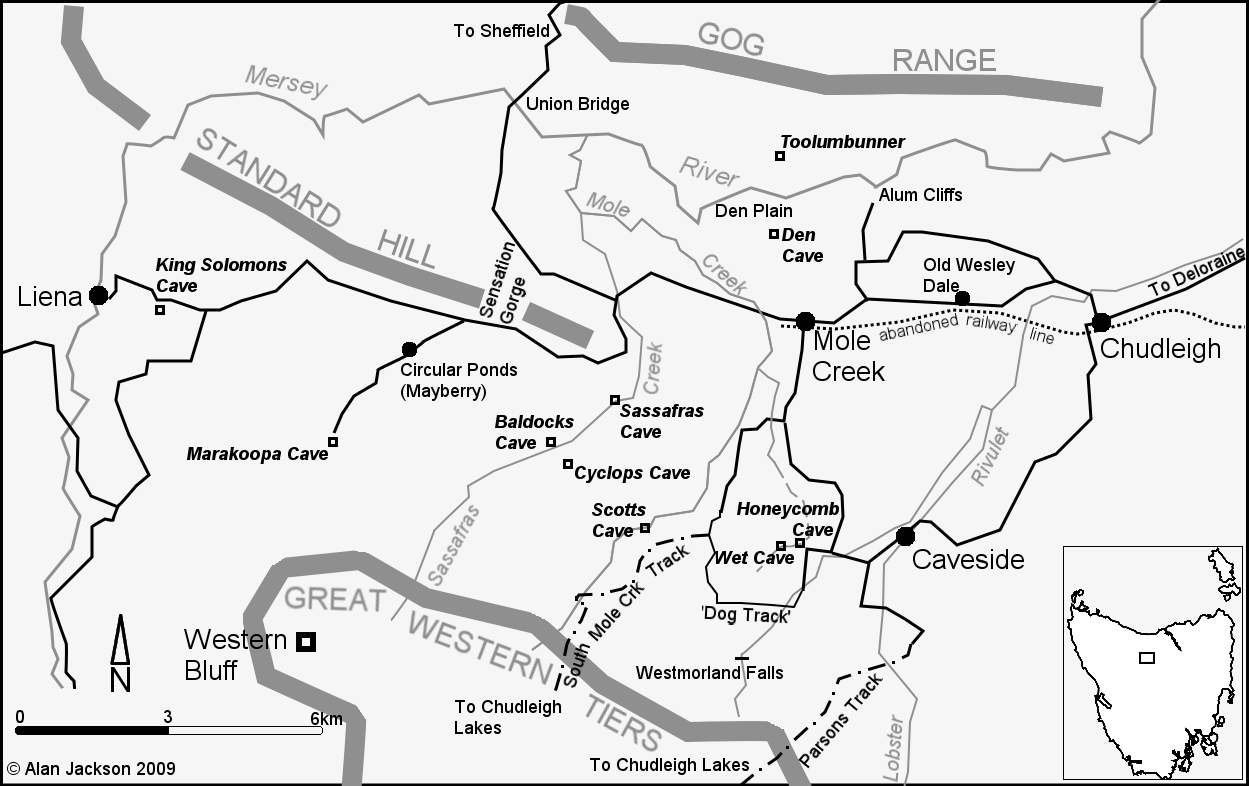
General map of the Chudleigh-Mole Creek district, showing the positions of Wet Cave, Chudleigh and Old Wesley Dale. Map by Alan Jackson.

Mole Creek flowing out of the main entrance of Wet Cave. Photo by Nic Haygarth.
Dan Pickett was born in Berkshire, England, probably in 1813, the son of a prostitute. His baptism record gives his name as ‘Daniel Picket’ and his mother as ‘Lucy Picket’.1 In 1832, as ‘Daniel Piggott’, he was sentenced to transportation to Australia for life for housebreaking. His Conduct Record bears a note that he had earlier been imprisoned on suspicion of highway robbery, and that he had ‘very bad connexions’. Pickett was described as 5 feet 6½ inches (168 centimetres) tall, with brown eyes, brown hair, a small, sharp nose and small mouth.2 He arrived in Hobart on the Jupiter in May 1833, and was assigned to Lieutenant Travers Vaughan, whose property ‘Native Hut Corner’, as the name suggests, occupied Aboriginal land on the frontier of European settlement.
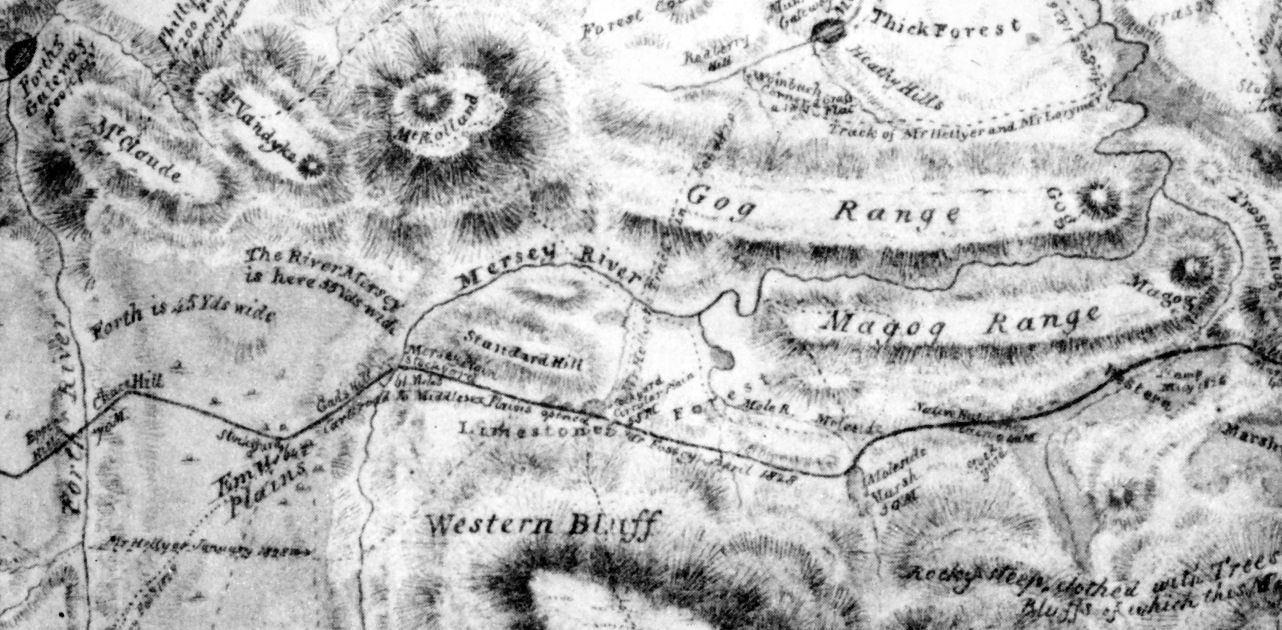
This detail from Henry Hellyer’s 1828 ‘Camp Drought’ map shows the location of ‘Native Hut Corner’ (right, south of ‘Magog Range’) and also the known existence of karst at Circular Ponds (‘Limestone Forest’). Courtesy of the Van Diemen’s Land Company.
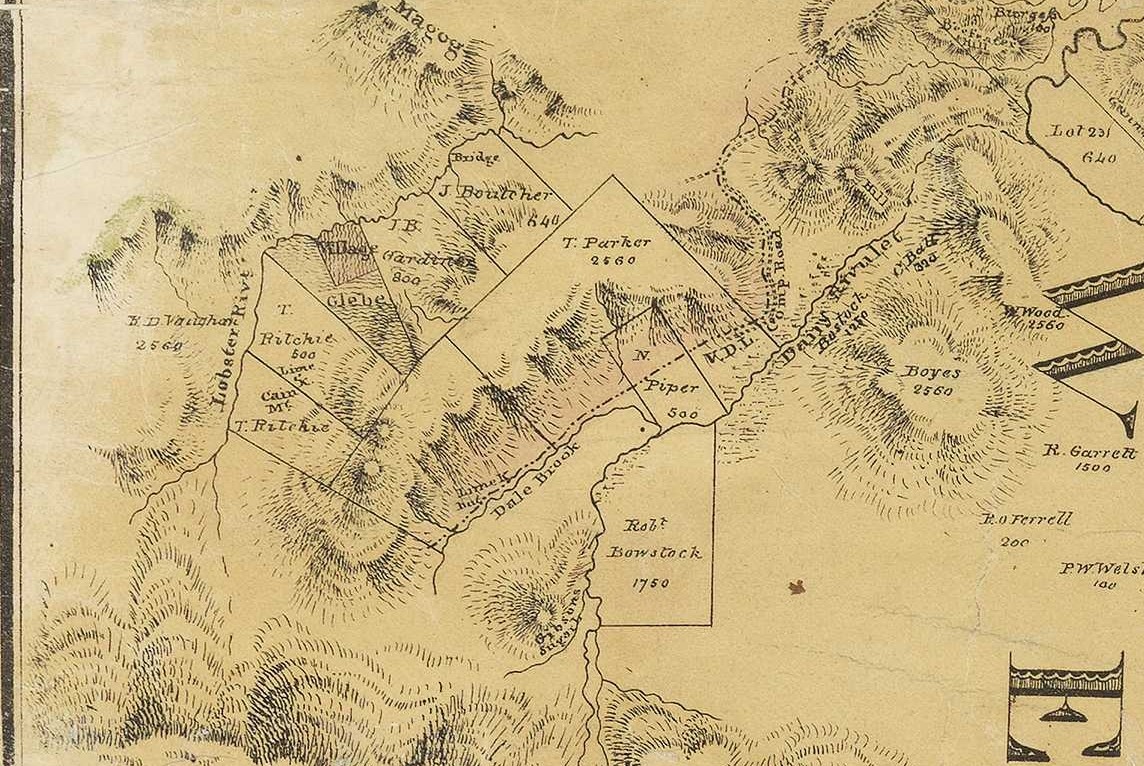
This detail from JL Hughes’ 1837 map of northern Tasmania shows the surveyed ‘village’ (Chudleigh) and Vaughan’s ‘Native Hut Corner’ property (left), soon to become ‘Wesley Dale’. Lime kilns are being worked on Thomas Ritchie’s property and along Dale Brook. Courtesy of the State Library of Tasmania, Launceston.
Although Wet Cave does not appear on JL Hughes’ 1837 map of northern Tasmania, it had probably been discovered by this time. George Augustus Robinson, the so-called ‘conciliator’ of the Tasmanian Aborigines, visited a cave at ‘Moleside Creek’ with Godfrey Bentley, Travers Vaughan’s nephew, in July 1834. ‘There are several caves on the Moleside Creek,’ Robinson noted, ‘one [possibly Honeycomb I Cave] about one hundred yards long and lofty.’ 3 ‘Native Hut Corner’ was Robinson’s supply depot and staging post in the Mole Creek region in 1832 and 1834.4 Bentley and Vaughan’s servants apparently explored the area: they guided Robinson to the ‘Moleside Creek’ caves and to the fishing spot near where Robinson entered Mersey Hill Cave. Although there is no record of Pickett claiming to have discovered Wet Cave, it is possible that he knew of it by the time of Robinson’s final visit to the area in July 1834.
Robinson described Vaughan as ‘kind hearted’ but in ‘embarrassed circumstances’.5 Perhaps the latter remark explains why in 1837 Vaughan sold ‘Native Hut Corner’ to the merchant and Wesleyan lay preacher Henry Reed, who renamed it ‘Wesley Dale’ (today it is known as ‘Old Wesley Dale’).6 Pickett passed into Reed’s employ. Reed was known to be a benevolent master who even allowed his charges alcohol in moderation.7 Pickett himself is quoted saying that Reed ‘never during his whole life had a single man punished’.8
Despite one misconduct charge, Pickett’s progress from this point was steady. In 1841 the 26-year-old received a ticket of leave, and in the same year he married 17-year-old Mary How (or Howe), the daughter of free-born immigrants.9 They had the first of their 15 children in 1842.10 By the following year, in which the couple’s second child was born, Pickett was overseer on a Dunorlan property not far from ‘Wesley Dale’.11 Later he rented farms, the final one being part of the ‘Wesley Dale’ estate, and he carted lime from Chudleigh to Launceston by bullock team.12 In July 1845, 13 years after his conviction in Berkshire, Pickett was pardoned.13
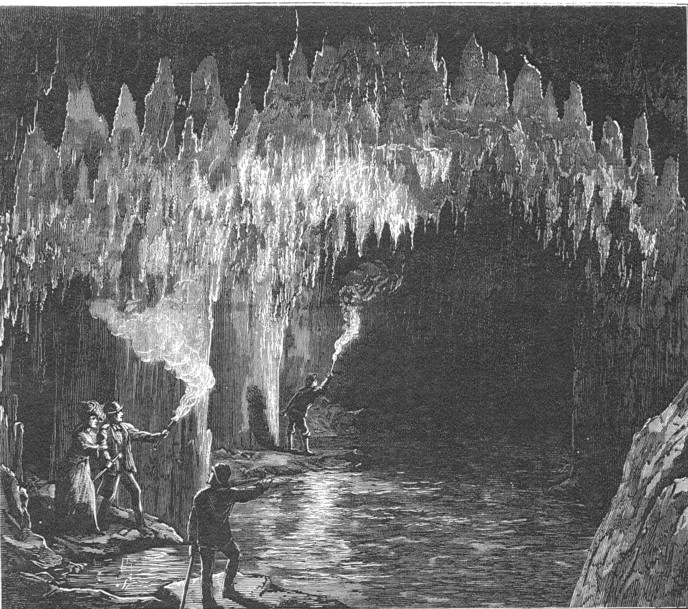
Bark torches light the way in ‘Oakden’s Cave [Wet Cave], near Chudleigh, Tasmania’. From Illustrated Australian News 1877.
Few people visited Wet Cave at this time. The earliest known report of sightseers in the cave is of an unguided trip in 1840.14 Three years later William Breton made the first known report of Tasmanian cave fauna when he described glow-worms in Wet Cave.15 Although Europeans found and explored limestone caves elsewhere in the Australian colonies at an earlier stage, Wet Cave appears to have been Australia’s first tourist or show cave.16

The Chudleigh Inn in its heyday and as it appears today. The top floor was removed from the building in 1937. Old photo from the Western Tiers newspaper courtesy of Bill James. Modern photo by Nic Haygarth.
The catalyst for this development was probably the establishment of the Chudleigh Inn in 1850 by John Ritchie, with William Motton its first licensee.17 The solid stone building still stands as a private home on the eastern edge of the Chudleigh village opposite the old Van Diemen’s Land Company store. In 1851 Motton transferred his public house licence to Joseph Sheen, who was the first to advertise the Chudleigh Inn as the gateway to the Westward Caves, as he called them, and a guiding service through those caves.18
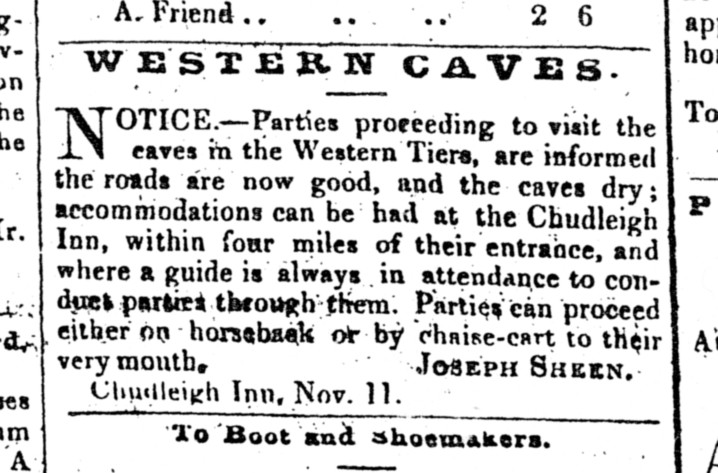
Cornwall Chronicle newspaper advertisement from 1851.19
In the 1850s Pickett became a man of substance. By 1853 he was licensee and owner of the Chudleigh Inn, had his own dairy and pig farm and even at least one farmhand.20 His purchase of the inn from John Ritchie for £400 suggests both personal enterprise and financial assistance, possibly from his former master Henry Reed.21
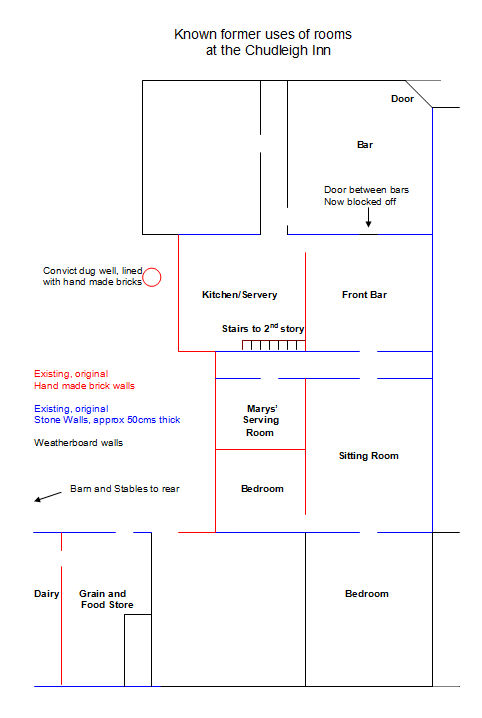
Plan of the Chudleigh Inn drawn by Wayne and Margaret Williams. In 1866 one of the Pickett children, Valley, drowned in the well behind the building.

Dan Pickett (centre of photo) outside the Chudleigh Inn. Note the door across the corner of the building, as depicted in the building plan. Courtesy of Bill James.
As the owner of a property worth at least £100, in 1856 Pickett qualified for the inaugural House of Assembly Electoral Roll for Deloraine.22 He became a sportsman, breeding and racing horses alongside the gentry and other ex-convicts who aspired to a higher status, and his expertise as a ploughman was on show in competitions.23 In 1875 he represented northern Tasmania in an intercolonial ploughing match.24 One of his leading racehorses was called Bolivar, presumably named after the South American revolutionary Simon Bolivar (1783–1830). This vague suggestion of left-wing political leanings is not in keeping with Pickett’s later identification with the British establishment!
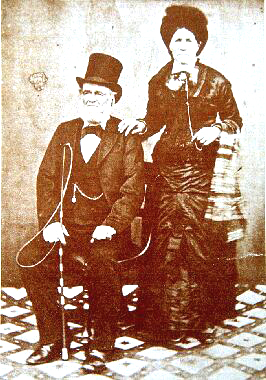
Dan and Mary Pickett in Sunday best. Photo courtesy of Rod How.
As the local hotelier, Pickett was at the centre of village activity, hosting public meetings and even inquests.25 Like Mary Pickett, who was the local midwife, he was heavily involved in the community, even becoming a provisional director of the ill-fated Mersey River and Devon Tramway between Deloraine and Latrobe.26 Pickett retained his public house licence for 47 consecutive years, despite two deaths at the Chudleigh Inn as the result of fights, each resulting in a conviction of manslaughter.27 There were regular thefts from the premises, of which the Pickett family was sometimes the victim, and a near-disastrous fire which killed one man and destroyed a stable, mares in foal, draught horses and harnesses.28 Pickett secured the contract to carry the mail between Deloraine and Chudleigh, which effectively made him the local passenger and freight operator between the two settlements.29 He owned and operated a store in the old Van Diemen’s Land Company quarters opposite the Chudleigh Inn. By his own enterprise an ex-convict had become the primary businessman of this country village.
He was also a keeper of local lore. In 1865 the surveyor James Calder, while riding east along the Van Diemen’s Land Company track, visited a tree stump at the ‘Black Heath’, somewhere between Circular Ponds and the Mersey River. On the stump now indecipherable words had been scrawled. Calder’s guide told him that the words had originally read
Underneath this lofty bower,
Where I passed my Christmas hour,
Along with those who took the pains
To cut the road to Emu Plains— 1827
The rest of the poem had presumably never been penned or had been obscured on the stump. Upon arrival at the Chudleigh Inn, Calder asked Pickett about the inscription. The publican had also visited the stump and had memorised the verse. He said that it had been written by the bushranger Samuel Britton, then a convict assigned to the Van Diemen’s Land Company’s track-cutting party. Pickett also revealed that he had once been Britton’s hostage.30 This no doubt referred to Britton’s attack on ‘Native Hut Corner’ in 1833, a few months after Pickett’s arrival there. Britton’s party apparently forced the assigned convict to carry its booty away from Vaughan’s property.31 Presumably it was during this captivity that Britton told Pickett of his poetics while he himself was on assignment in 1827.

Advert for Pickett’s mail service, Tasmanian newspaper 3 February 1872, p.16. This suggests that Pickett sold a cave tour package centred on the Chudleigh Inn rather than just his cave guiding service.
So what is recorded about Pickett’s involvement with caves? In 1866 he guided a party through Wet Cave—the only documented account of Pickett guiding prior to the Trollope and Du Cane visit.32 Picket also supplied Chudleigh marble to the Intercolonial Exhibition in 1866.33 More interestingly, in 1873 Pickett testified in court against Henry Callaghan, a man alleged to have injured ‘the Chudleigh Caves’, in an incident which prompted the local Deloraine Council to instigate the process of establishing Tasmania’s first cave reserves in 1879.34 Trollope describes Pickett, probably accurately, as an expert horseman in his account of the 1872 Wet Cave visit:
On our journey an old man attached himself to us, who seemed to have the caves under his peculiar care, and who assured us that he had shown all the governors over them. He came out upon us from a public-house, of which he was the proprietor, and promising us that we should have the benefit of his services, followed us on a wonderful rat-tailed mare with which he jumped over every obstruction along the road, and made himself very busy, assuring the governor that no governor could see the caves aright without him, and taking command of the whole party with that air of authority which always carries success with it. I think his name was Pickett. We soon found that we were creatures in Mr Pickett’s hand.35
Pickett drove them his charges and on through the cave by candle light, assuring them that there was no danger and that there are many wonders still to see. Finally they rebelled and turned back:
… we were cold to the marrow of our bones, wet through, covered with mud, and assured that, if we did go on, the journey must be made partly on our hands and knees, and partly after the fashion of the serpents.36
Trollope’s book Australia and New Zealand, published in 1873, made Pickett a minor celebrity. It depicted him as the long-term custodian of Wet Cave, a role apparently given vice-regal recognition throughout his time in Tasmania. Pickett told Governor Du Cane that ‘he [Pickett] should not enter the cave again till another governor should come to see them.’ So this veteran cave custodian now restricted himself to vice-regal visits. It was an outrageous piece of self-promotion.
In 1873 there was no village of Mole Creek. It was still 17 years before the railway would reach Chudleigh, and 21 before railway excursions from Launceston would turn the caves into a day trip destination. Visitors to the caves needed accommodation and transport. The Chudleigh Inn was regularly cited as the base for cave visits.37 Pickett’s personal legend blossomed during this time:
Reports which developed Pickett’s legend
- 1873—Pickett claimed that he had shown the caves to ‘all the governors’ and now only guided governors.38
- 1873—Pickett stated that he had travelled 3.5 miles (5.6 kilometres) into Wet Cave.39
- 1873—Pickett claimed that he had travelled beyond ‘where the water is said to almost fill the cave to the roof’ in Wet Cave, that is, beyond the ‘Rockfall’ into what is now called Georgies Hall.40 (The ‘Rockfall’ is thought to have not been breached until the Southern Caving Society forced their way through it from Georgies Hall into Wet Cave during the 1960s.)41
- 1883—Pickett said he had guided all governors from Colonel George Arthur (1824–36) to Frederick Weld (1875–80), that is, eight governors, including Sir John Franklin and his wife Lady Jane Franklin. The capsizing of the Franklins’ carriage in a narrow defile, Pickett claimed, prompted that place to be named Needles. Pickett ‘recalled Windsor and Eton’, enjoying ‘a confab about castle and college’. Pickett also recalled an Aboriginal attack on the Native Hut Corner property when he was assigned to Travers Vaughan.42
- 1887—Pickett reiterated a claim already made to James Calder, that he had been held hostage by Samuel Britton’s gang of bushrangers in 1833.43
- 1899—Pickett stated that he guided visiting amateur geologist Count Strzelecki in the bush in 1844.44
Can we assume that Pickett was reported accurately? Did Pickett, for example, imply that he had attended the prestigious Eton School, or was that construction placed upon his words by his 1883 interviewer, Mercury newspaper reporter Theophilus Jones? (Given that Windsor and Eton are only a few kilometres from Pickett’s native place, Maidenhead, it is very likely that he could recall both places.) We have no Pickett autobiography, not even a letter written or dictated by him. Pickett’s resumé as prepared by his interviewers, however, now effectively included association with two forms of vice-royalty—Tasmanian governors and a pretend Polish count—plus predations by Aborigines and European outlaws. Claims of hobnobbing with vice-royalty suggest self-promotion or self-purification by the ex-convict. Portraying himself as the victim of Aboriginal and bushranger attacks looks like an attempt to identify with the landed gentry. Such stories also enhanced Pickett’s status as larger-than-life custodian, lore keeper and explorer of Wet Cave.
Which of the claims can be verified? The story of Aboriginal attack and the Britton story are plausible. Pickett appears to have been an overseer at Dunorlan, several kilometres from the Van Diemen’s Land Company track, in 1844 when the wandering Strzelecki is said to have acquired his services. If Strzelecki did meet Pickett, it is more likely to have been when he was working nearer the track at ‘Wesley Dale’ at an earlier date. Pickett’s familiarity with Britton’s inscription at ‘Black Heath’ is consistent with Strzelecki engaging him as a guide along the Van Diemen’s Land Company track. Overall, the Strzelecki story is plausible.
The story of Pickett guiding Governor Arthur is not. Arthur’s only trip to the region was in 1829, before Pickett’s arrival, and although his party entered a cave it was at Circular Ponds, not Wet Cave.45 While the Franklins visited the north of the colony in 1837 and 1843, there is no record of them venturing to Chudleigh or Wet Cave.46 Yet, by 1853 the placename Needles, where the Franklins are said to have come a cropper, was on the map, perhaps as the result of a similar, now anonymous mishap.47
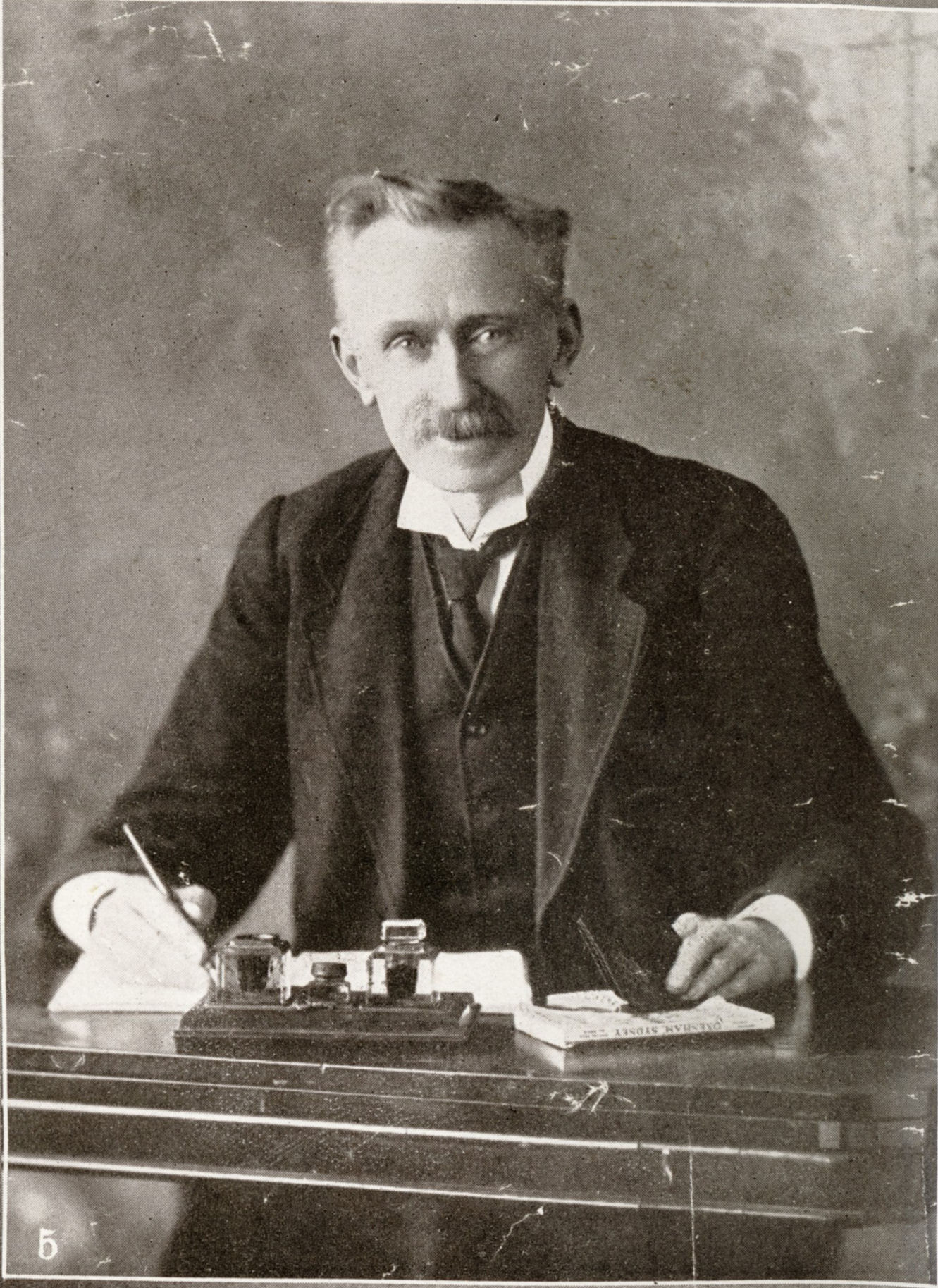
Dan Griffin, aka ‘The Tramp’, wry-witted highland raconteur and journalist, who reported Pickett’s recounted exploits. Photo from Weekly Courier newspaper 1923.
It is the detail in the Franklin story that makes it sound plausible. One of Pickett’s interviewers was an equally colourful and self-promoting personality, the journalist Dan Griffin. After Pickett’s death, Griffin divulged further details of the Franklin party’s adventures visiting Wet Cave. Pickett had told him that Sir John Franklin had made two visits to the cave, with Lady Jane accompanying him on the second occasion. The aide-de-camp Elliott was now blamed for overturning the vice-regal carriage because, as Pickett reportedly told Griffin, a man might as well be expected to drive through the eye of a needle as through the high rocks through which the bush track wound its way. With Pickett in his grave, Griffin felt free to note wryly that ‘all the Dans, from the time of the lion tamer down to date, have been noted for vivid imagination, as well as piety’. (‘All the Dans’, of course, included Dan Griffin, whose own unreliability, if not his vivid imagination, is evident elsewhere in the same story.) Notably, Griffin, who as a policeman was part of Frederick Weld’s entourage when the Governor visited Wet Cave in 1878, does not report Pickett guiding the vice-regal party.48
Pickett died in 1899 at the age of about 86—but his legend was not yet done.49 He left his wife Mary £1,051, none of which she spent giving him a headstone in St Mark’s Cemetery in Deloraine.50 Perhaps if she had it would have prevented Sir Hudson Fysh, in his biography of Pickett’s former employer Henry Reed, claiming to have met Pickett at the Chudleigh Inn in 1912, 13 years after his death. Pickett, says Fysh, must have been nearly 100 when he met him—and so Pickett would have been had he still been alive in 1912.51
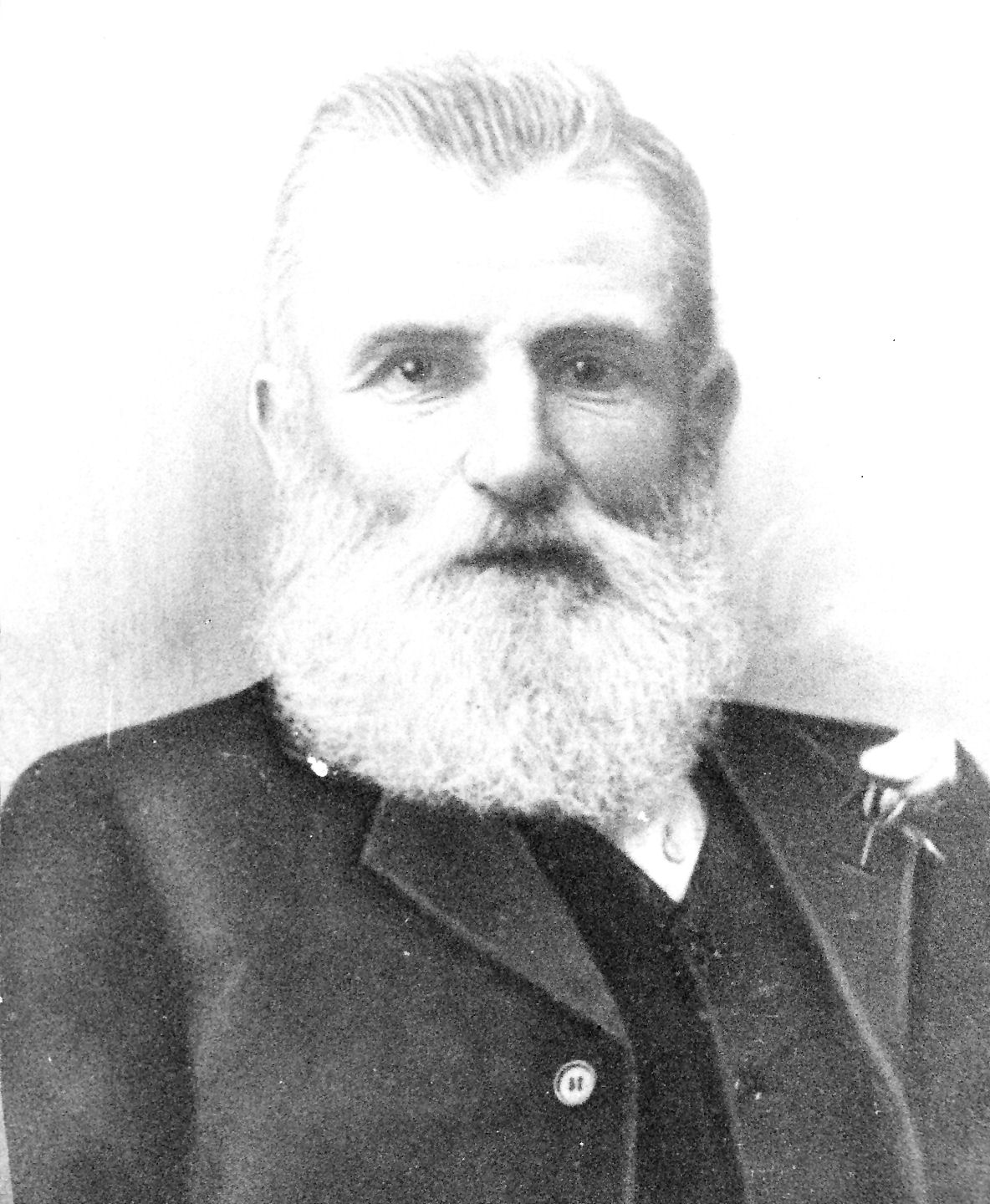
William Woodhouse, alleged discoverer of the Gunns Plains Cave. Photo courtesy of Terry Woodhouse.
The similarities between Pickett’s legend and that of alleged Gunns Plains Cave discoverer William Wallace Woodhouse are striking. Like Pickett, Woodhouse belonged to an era in which Tasmania was the penal destination of the Southern Hemisphere. He had Pickett’s measure as raconteur and Methuselean patriarch. In old age he claimed to recall the ‘Black Line’ advance against the Tasmanian Aborigines in 1830, the murder of white settlers by Aborigines in 1831 and the predations of various bushrangers—the only problem being that Woodhouse was not born until 1842. In 1930 the mathematically-challenged Woodhouse claimed to be celebrating the centenary of his birth at Kirkcaldy in Scotland.52 His faulty reminiscences may have been designed to hide his convict parentage, and perhaps his ambiguous marital status. Woodhouse was actually born in Launceston in 1842, making him 90 when he died, not 102.53 The stigma of convictism troubled Tasmanians for generations after transportation of convicts ceased in 1853. Pickett and Woodhouse both reinvented themselves in their quest to escape it, and in doing so built a legendary status as raconteur cave keepers.
Following on from Joseph Sheen, Dan Pickett was one of Australia’s earliest cave tourism operators. He supplied lodging, horses and guides to Wet Cave tour parties. Sometimes he himself was the guide, and on at least one occasion one of his sons did the job.54 Confirmation of the story of him guiding Sir John and Lady Jane Franklin through Wet Cave in the 1830s would probably make him Australia’s first professional cave tour guide. It is likely, however, that his vice-regal cave guiding career developed retrospectively in his own mind after the social benefits of guiding Governor Du Cane in 1872 became apparent. The possibly illiterate ex-convict was certainly media savvy. How much of his legend is a lie may now never be known.
Acknowledgements
Discussions with Arthur Clarke helped clarify some of the issues addressed by this paper.
References
- He was baptised at East Lockringe or Cookham in Berkshire 14 November 1813, England and Wales Christening Records 1530–1906 (Ancestry database).
- See Conduct Record CON31/1/35, Appropriation List CON27/1/6 and Description List CON18/1/11, p.235 (Tasmanian Archive and Heritage Office).
- George Augustus Robinson, Friendly Mission: the Tasmanian Journal and papers of George Augustus Robinson, 1829–1834 (ed. Brian Plomley), 2nd edn., Queen Victoria Museum and Art Gallery, Launceston, 2008, 27 July 1834, p.943.
- For Robinson’s two earlier visits to ‘Native Hut Corner’, see Friendly Mission 8 April 1832, p.631 and 18 January 1834, p.871.
- George Augustus Robinson, Friendly Mission 8 April 1832, p.631.
- Fysh, Henry Reed, pp.56 and 72. Vaughan’s conveyance of ‘Native Hut Corner’ to Reed was registered 1 August 1837 (Land Titles Office, Department of Primary Industries, Parks, Water and Environment, Hobart).
- Fysh, Henry Reed, p.14.
- Fysh, Henry Reed, p.93.
- ‘Government Notice no.71’, Courier 30 March 1841, p.2; marriage record 7 September 1841, no.1194/1841 (Tasmanian Pioneers Index).
- Incomplete and inaccurate records make the exact number of children hard to determine. The childbirths registered to Daniel Pickett and Mary Howe were (unnamed on birth record unless otherwise specified) female born 7 August 1842 (no.1095/1842), Lucy born 23 November 1843 (no.1804/1843), Arthur Daniel born 12 February 1847 (no.804/1847), female born 12 November 1848 (no.1014/1848), male born 26 March 1850 (no.1225/1850), male born 16 January 1852 (no.644/1852), female born 24 January 1854 (no.1240/1854), female born 26 August 1855 (no.1621/1855), female born 28 September 1857 (no.345/1857), male born 24 May 1859 (no.275/1859), female born 3 December 1861 (no.248/1862), male born 4 April 1863 (no.293/1863) and female born 30 October 1864 (no.569/1864). Another child, Deliah Picket, born 15 November 1845 (no.1160/1846), and attributed to Daniel and Ellen Picket, is likely to be theirs also. The father’s surname on these birth records is given variously as Picket, Pickett or Pukitt, the mother’s as How or Howe. The existence of another daughter, Valley, is known only from a newspaper report of her drowning in the well at the Chudleigh Inn at the age of two years and from her death record (‘Our Monthly Summary’, Examiner 18 December 1866, p.2; 13 December 1866, no.122/1866, Tasmanian Pioneers Index). The couple may have had more than 15 children, as there are other deaths registered at Deloraine to children with the surname of Pickett or Picket during relevant years.
- ‘Insolvent Court’, Examiner 8 June 1844, p.6.
- ‘The Tramp’ (Dan Griffin), ‘An Octogenarian’, Daily Telegraph 25 November 1893 and ‘Some More About Chudleigh’, Daily Telegraph 2 December 1893; reprinted in (ed. K Bonney), Early Deloraine: the Writings of Louisa Meredith and Daniel Griffin, Regal, Launceston, undated, pp.48 and 51 respectively. Early settlers in the Chudleigh region, Gardner, Ritchie and Vaughan, burned limestone in kilns.
- See Conduct Record CON31/1/35 (Tasmanian Archive and Heritage Office).
- ‘The Oak-Den Caves’, Cornwall Chronicle 8 February 1840.
- Examiner 2 December 1843; repeated in ‘Excursion to the Western Range, Tasmania’, Tasmanian Journal of Natural Science, vol.II, 1846, pp.138–39.
- Caves were known and explored in the Wellington Valley in New South Wales by 1826 and at Buchan in Victoria by 1840. See David Hearn, ‘Wellington Caves: Past and Present’, Cave and Karst Management in Australasia 9: Proceedings of the 9th Australasian Cave and Karst Management Association Conference, ACKMA, Margaret River, 1991; and Bob Haldane, ‘A Caving Pioneer: Frank Moon and the Caves of Buchan’, Cave and Karst Management in Australasia 17: Proceedings of the 17th Australasian Cave and Karst Management Association Conference, ACKMA, Buchan, 2007.
- Ritchie bought the four acres as four separate one-acre Crown blocks in the village of Chudleigh in 1849, paying a total of £24 (‘Sale of Crown Lands’, Examiner 3 March 1849, p.5). For Motton’s licence, see list of liquor licence holders, Hobart Town Gazette 1 October 1850, p.872–74.
- ‘Westbury’, Courier 19 February 1851, p.2;
- Cornwall Chronicle 19 November 1851, p.739.
- For employment of a farmhand, see ‘Inquests’, Examiner 14 January 1852, p.5.
- Memorial of sale no.4/952, dated 21 July 1852. The conveyance was not registered until 9 March 1855 (Land Titles Office, Department of Primary Industries, Parks, Water and Environment, Hobart).
- ‘List of Persons Entitled to be Placed on the Electoral Roll…’, Examiner 8 April 1856, p.2.
- For Pickett in hurdle racing, see ‘Hurdle Race’, Examiner 14 April 1864, p.5; ‘Chudleigh Races’, Examiner 7 January 1865, p.3; ‘Deloraine Races’, Examiner 7 April 1866,p.3; ‘Trial of the Hunters’, Mercury 6 December 1875, p.2. For Pickett’s horses in competition at agricultural shows, see ‘North-West Agricultural Show’, Mercury 28 October 1880, p.3; ‘Western Agricultural Show’, Examiner 25 November 1880, p.3; and ‘North-Western Agricultural Show’, Mercury 27 October 1881, p.2. In 1854 Pickett was treasurer of the Chudleigh Ploughing Association (advert, Examiner 1 August 1854, p.1).
- For Pickett representing the north in intercolonial ploughing matches, see ‘Intercolonial Ploughing Matches’, Mercury 17 September 1875, p.2.
- See, for example, advertisement for the Chudleigh Road Trust meeting at the Chudleigh Inn, Hobart Town Mercury 27 May 1857, p.1.
- Jill Cassidy, Deloraine’s Industrial Heritage: a Survey, Australian Heritage Commission and the Queen Victoria Museum, Launceston, 1986, p.119.
- See ‘Deaths from Pugilism’, Courier 12 February 1858, p.2, in which ‘Ned the Bullock Driver’ dies as the result of a scuffle at the Chudleigh Inn; ‘General News’, Examiner 22 January 1876, p.3, in which George Monaghan kills James Phillips at the Chudleigh Inn (Monaghan was later convicted of manslaughter and sentenced to a year in prison). The Deloraine Police Felony Reports Book records the killing of Phillips (POL126/1/1, Tasmanian Archive and Heritage Office, Hobart).
- See ‘Robbery from the Person’, Examiner 8 October 1864, p.3, in which Pickett testifies against a thief at the Chudleigh Inn. The Deloraine Police Felony Reports Book records a burglary at the Chudleigh Inn 10 May 1869. On 6 December 1877 Pickett’s store was broken into (POL126/1/1, Tasmanian Archive and Heritage Office, Hobart). For the fire, see ‘Fire and Loss at Chudleigh’, Examiner 13 April 1865, p.4.
- ‘Official Notices’, Examiner 18 January 1872, p.3. Pickett contracted to cart mail between Deloraine and Chudleigh for £33 per year, which by 1878 had increased to £45 (‘Official Notices’, Examiner 9 January 1878, p.3).
- James Calder, ‘Notes of a Journey’, Tasmanian Times 18 May 1867, p.4.
- For a contemporary report of Britton’s visit to Vaughan, see editorial, Hobart Town Courier 25 October 1833, p.2.
- ‘The Chudleigh Caves’, Examiner 25 January 1866, p.5.
- ‘Intercolonial Exhibition Commission’, Mercury 4 July 1866, p.2.
- ‘Deloraine Municipal Council’, Examiner 6 May 1873, p.4. There is confusion about which cave was injured, Wet Cave or Sassafras.
- Anthony Trollope, Australia and New Zealand (eds. PD Edwards and RB Joyce), University of Queensland Press, Brisbane, 1967, pp.45–46.
- Anthony Trollope, Australia and New Zealand, p.47.
- See, for example, Howard Hayward, Through Tasmania: Howard Haywood’s Illustrated Guide for Visitors and Colonists 1885–6, Examiner, Launceston, 1885, p.17; or the Union Steam Ship Company’s Tasmanian Guide for Visitors to Tasmania, Union Steam Ship Company, Launceston, 1891, p.44. William Senior, who hired horses at the Chudleigh Inn in 1880, presumably mistook one of Pickett’s sons for the publican, reporting that ‘the landlord of the inn at which we stop during our stay is a most obliging young fellow’ (William Senior, Travel and Trout in the Antipodes, Chatto and Windus, London, 1880, p.49).
- Anthony Trollope, Australia and New Zealand, p.47.
- ‘The Fire Brigade’s Trip to Chudleigh Caves’, Examiner 4 January 1873, p.5.
- ‘A Flying Visit to Tasmania’, Mercury 22 February 1873, p.3.
- Interview with Bob Cockerill and Barry James 27 August 2010.
- Theophilus Jones, ‘Through Tasmania: no.18’, Tasmanian Mail 15 December 1883, pp.27–28. Dan Griffin (‘Old Dan’, ‘Chudleigh Caves’, Examiner 11 November 1890, p.3) adds Lady Jane Franklin’s aide-de-camp Elliott to the party which supposedly entered Wet Cave in 1838. In 1893 Griffin claimed that Strahan and Hamilton were the only governors since Franklin’s time to have not visited Wet Cave (‘The Tramp’ [Dan Griffin], ‘Deloraine Past and Present: no.9: an Octogenarian’, Daily Telegraph 25 November 1893; reprinted in [ed. K Bonney], Early Deloraine: the Writings of Louisa Meredith and Daniel Griffin, Regal, Launceston, undated, pp.46–49).
- ‘A Correspondent’ (James Smith), An Episode of the Early Days of Tasmania’, Examiner 2 May 1887, p.3.
- ‘Dan Griffin, ‘Deloraine’, Tasmanian Mail 19 December 1899, p.29.
- ‘Van Diemen’s Land’, Hobart-Town Courier 7 February 1829, p.2.
- Only fragments of Lady Jane Franklin’s diaries and correspondence from her time in Tasmania have survived. None mention caves. They are held by the University of Tasmania Archives, Hobart.
- See, for example, advertisement for the Chudleigh Road Trust, Examiner 15 November 1853, p.4.
- ‘DDG’ (Dan Griffin), ‘Vice-royalty at Mole Creek’, Examiner 15 March 1918, p.6. Later in the story, Griffin confused the ex-convict stockman John Francis, whom he claimed to know well, with a Launceston namesake who was transported for treason.
- ‘Country News’, Examiner 4 January 1900, p.8. See also burial records for St Mark’s Anglican Church, Deloraine.
- ‘Testamentary’, Examiner 11 December 1900, p.7.
- Sir Hudson Fysh, Henry Reed: Van Diemen’s Land Pioneer, Cat and Fiddle, Hobart, 1973, p.91.
- ‘Death of Gunn’s [sic] Plains Centenarian: Born When William IV Was King: Hardy Scot’, Advocate 27 December 1932, p.6.
- Thanks to Terry Woodhouse, Melbourne, for his research.
- ‘A Flying Visit to Tasmania’, Mercury 22 February 1873, p.3.